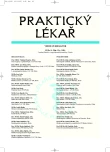Three hundreds pancreas transplantations in the Institute of Clinical and Experimental Medicine in Prague
Authors:
F. Saudek 1; M. Adamec 2; P. Bouček 1; R. Kožnarová 1; K. Lipár 2; L. Janoušek 2; Z. Vlasáková 1; V. Lánská 1; V. Bartoš 1
Authors‘ workplace:
Klinika diabetologie
Přednosta: Doc. MUDr. František Saudek, DrSc.
1; Klinika transplantační chirurgie
Přednosta. Doc. MUDr. Miloš Adamec, CSc.
Institut klinické a experimentální medicíny, Praha
Ředitel: MUDr. Štefan Vítko, CSc.
2
Published in:
Prakt. Lék. 2007; 87(2): 76-81
Category:
Reviews
Overview
Pancreas transplantation is currently the only standard clinical method that is able to induce long-term normoglycemia in subjects suffering from type 1 diabetes mellitus. It is most frequently performed simultaneously with kidney transplantation and only rarely as an independent procedure. More than 300 pancreas transplants have been performed since the introduction of the program in IKEM in 1983. The aim of this communication is to evaluate the overall results in 4 time periods.
Segmental pancreas transplantation with duct obliteration was performed in the first 38 cases (1983-1990). Whole-pancreas transplantation with drainage of the pancreatic duct into the urinary bladder was performed from 1994 (264 cases), and intestinal drainage has been used since 2000. Pancreas transplantation was only performed in 21 non-uremic type 1 diabetic subjects (including 3 retransplants). Thirteen recipients with a functioning kidney graft underwent subsequent isolated pancreas transplantation.
Cumulative patient, pancreas and kidney survival was assessed in 4 time periods according to the year of the transplantation. Three-year patient, pancreas and kidney graft non-censored survival rates in transplants performed between 2000-2006 were 96, 76 and 82 %, respectively. These results are comparable with those reported in the USA in the same period. Although the number of urological complications considerably decreased following the introduction of intestinal drainage of the pancreatic duct, surgical complications still remain the most frequent cause of pancreas graft failure in the first year. In comparison with the group who had undergone a kidney transplant, the long-term course of diabetic retinopathy and neuropathy and the quality of life were better in the pancreas and kidney recipients. Though isolated pancreas transplantation in non-uremic recipients completely eliminated the life-threatening hypoglycaemic episodes, the long-term pancreas survival rate in this group remained inferior to that seen in simultaneous pancreas and kidney transplant patients.
Combined kidney and pancreas transplantation still represents the optimal treatment for uremic type 1 diabetics, and its long-term outcome is now very satisfactory, although further slight improvements may be made. Isolated pancreas transplantation remains reserved for a narrow group of patients with very labile diabetes. Transplantation of isolated Langerhans islets is an alternative option that is substantially safer for patients; however, for the time being, the long-term results are inferior.
Key words:
Diabetes mellitus type1, pancreas transplantation, kidney transplantation, diabetic nephropathy, hypoglycaemia.
Labels
General practitioner for children and adolescents General practitioner for adultsArticle was published in
General Practitioner

2007 Issue 2
Most read in this issue
- Risk of malnutrition and nutritional support in Alzheimer disease
- Active search for prostate cancer by PSA testing in GP surgery
- The legacy of I. F. Semmelweis; key milestones in the development of hospital hygiene and current challenges.
- Symptomatic diabetic neuropathy: irreversible nerve damage?
